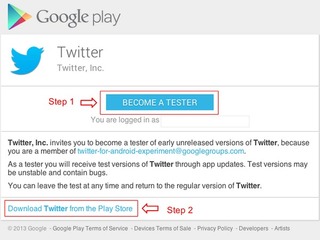

Android is quickly becoming the dominant platform, beating iOS for both tablet and smartphone shipements worldwide this past quarter. Twitter has already seen the effect that an Android launch can have: it’s Vine app tripled its userbase in two months after being released onto Android.
So it is obviously in Twitter’s best interest to keep its Android users happy. And what better way than to let them tell Twitter directly what they do, and do not, like.
To make this happen, Twitter has created a new group on Google called “Twitter for Android Experiment,” which allows users to sign up to test out new features on the Twitter app before they are released to the public.
If accepted, users will be promoted to update their Twitter app when a new build is ready. The experimental build will replace the Twitter app on their Android device. As expected, the new app may be buggy, and Twitter expects those users to report any problems they are having with it.
So, yeah, your Twitter app might start freaking out on you. But here’s the cool part: those who participate might actually get to see and play around with feature that never make it onto the actual app.
The program has been created, Twitter said, to “help us improve Twitter for Android and make it more accessible to people around the world, across a range of Android devices.”
Users can sign up here and then click “Become a Tester” to opt into the program. Then Click “Download Twitter from the Play Store” to update the Twitter app. If a user is chosen, they will then begin getting weekly updates with “new experiments” to play with.
Of course, some people who opt in might then bristle at their Twitter app being all funky. So they have the ability to opt out by clicking on Leave the test in the Google Play Store.
Those users who become Twitter testers might be seeing some very cool features pop up. Twitter recently introduced related headlines, which lists, and then links, to the websites where the Tweet has been embedded.
The site also recently overhauled how users view conversations, making them clearer by adding a blue line between them on the left hand side. The first tweet appears at the top and, if there are more than two replies, clicking on the blue line will show all the replies in that conversation.
And that is to say nothing of what Twitter has been doing with television engagement. The company has recently been experimenting with a new “TV trending” box that will highlight which shows are being talked about in real-time.
Why Android?
The fight between iOS and Android looks to basically be a done deal at this point, as Android is dominating on both tablets and smartphones.
In the second quarter of 2013, Android completely dominated tablets, with 67% of the global market share, according to numbers released by Strategy Analytics last month.
Android shipped 34.6 million units. That is compared to only 28.3% for Apple, or 14.6 million units.
When it comes to smartphones, Android holds an even bigger share: 79.3%, good for 187.4 million units shipped last quarter.
That is a more than 10% jump from the 108 million united shipped in the same quarter in 2012, which gave the operating system a worldwide share of 69.1%.
Apple, on the other hand, went the other direction. In the second quarter of 2013, iOS saw 31.2 million smartphone units shipped, for a 13.2% market share. That is down over 3% from the 16.6% market share it saw a year ago.
It wasn’t all bad news for Apple: the company still saw a 20% increase in shipments, up from 26 million in the second quarter of 2012. But the fact that it saw a loss of marketshare, while Android saw such big gains, is a good enough reason for a site like Twitter to do whatever it can to capitalize on that growth.
(Image source: https://groups.google.com)















